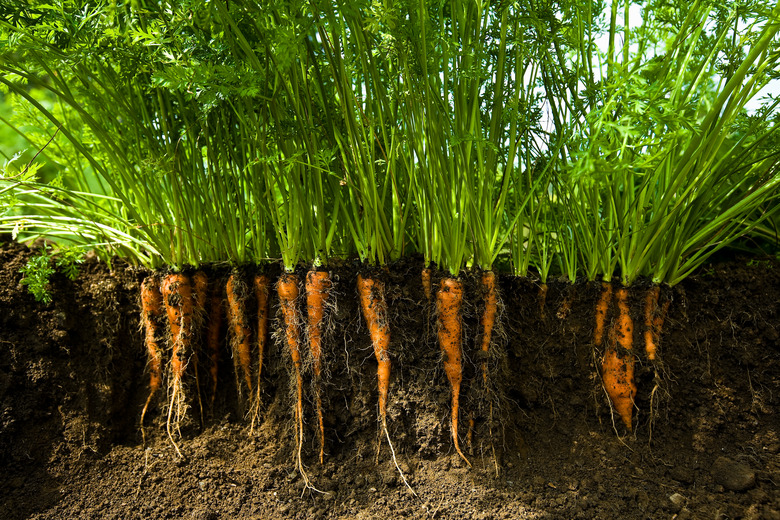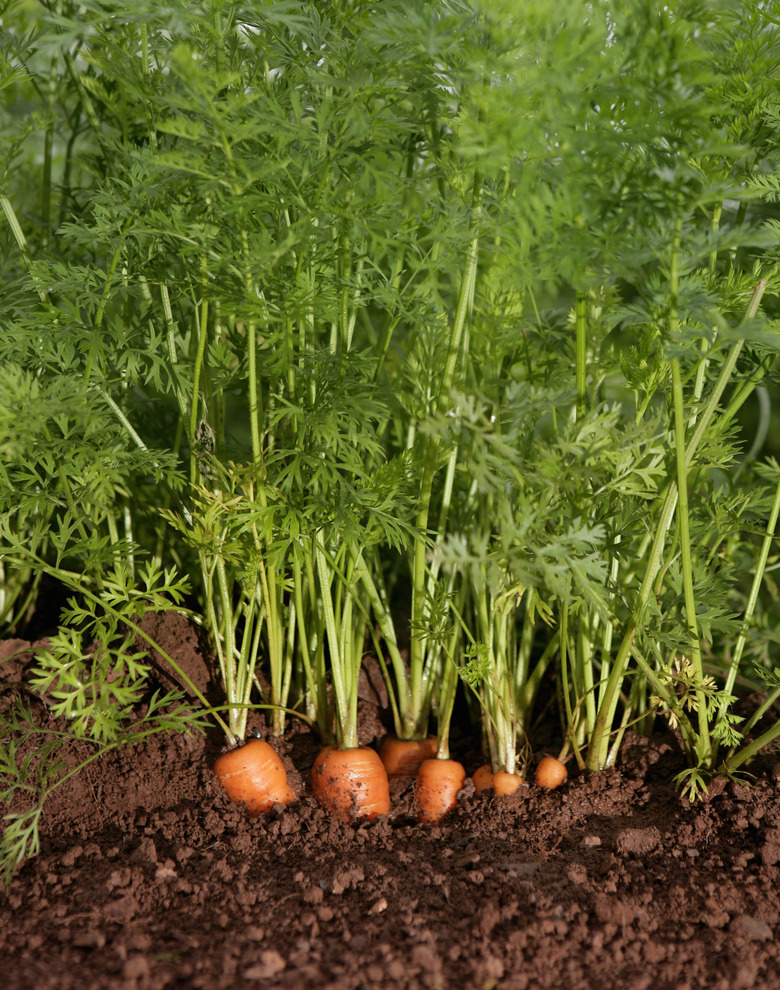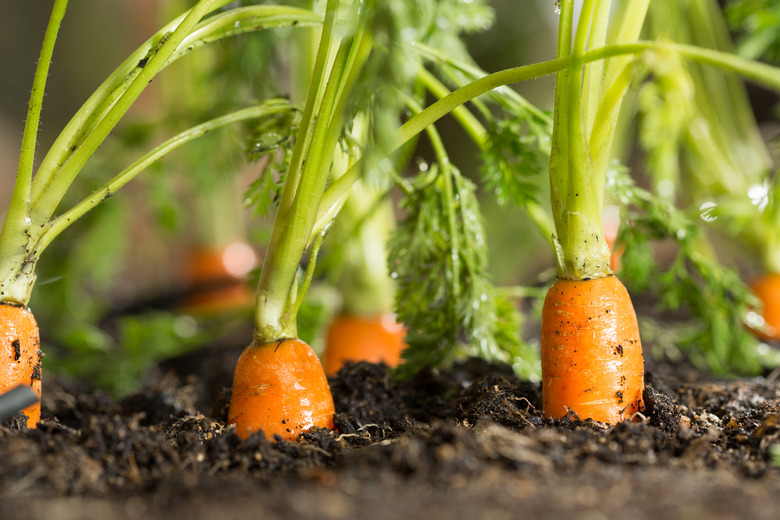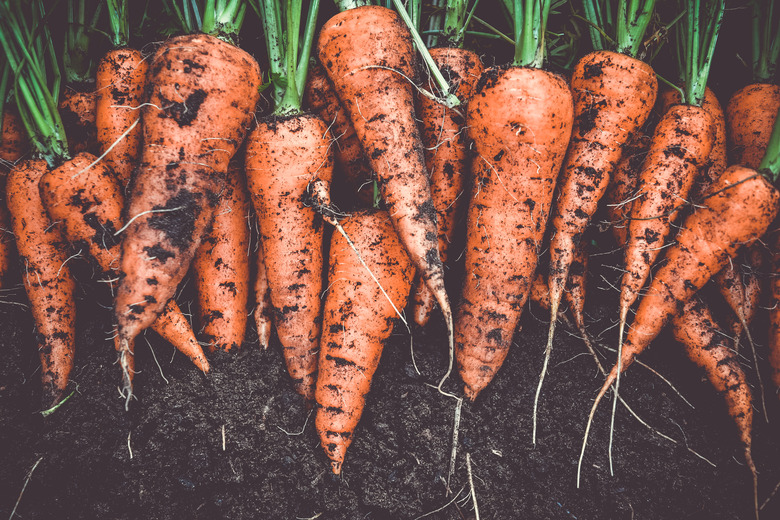How To Grow Carrots
We may receive a commission on purchases made from links.
- Best uses for carrots
- How to grow carrots
- In what zone do carrots grow best?
- When should you plant carrots?
- Soil, sunlight and water recommendations for carrots
- How to propagate carrots
- How to winterize carrots
- How to harvest carrots
- Common pests and other problems for carrots
- Common diseases for carrots
When you see Queen Anne's lace growing in a field in your neighborhood — which is likely since it's widespread enough to be considered a weed — you might not associate it with the carrots on which you snack, but they're closely related. The main difference is that Queen Anne's lace (Daucus carota var. carota) is the wild carrot, and the garden carrot (Daucus carota var. sativus) is the variety that has been cultivated for centuries as a root vegetable. Carrot roots are the edible parts of the plants, and while you can eat wild carrots when they're young, cultivated carrots are tasty no matter when you harvest them.
The carrot is the taproot of a green, bushy, biennial plant that grows to a height of 2 to 4 feet during the first season, and if left over the winter, it sends out large stalks that develop tiny pinkish or white flowers from which come spiny seeds. If you're planting carrots in your garden, you will probably harvest the tasty taproots at the end of the growing season, so you might not ever get to notice the similarity between the domesticated carrot during its second growing season and the wild carrot plant, which produce similar flowers.
The carrot plant grows best in cool, loose soil, and it loves full sun, although it can tolerate some shade. Ideal growing temperatures are between 55 and 75 degrees Fahrenheit, and you can plant it from early spring to late summer. You can harvest the root as soon as it is big enough to eat, although young carrots and ones left in the ground until winter are particularly tasty. Some favorite carrot selections are:
- Amsterdam: Small and tasty, these grow about 3 inches long and are suitable for containers.
- Danvers Half Long: Thick and hardy with a rich taste, it grows about 7 inches long.
- Little Finger: A gourmet carrot that grows 3 to 5 inches in length. It is great for containers.
- Imperator: One of the longest carrots, it grows 10 inches in length.
- Thumbelina: This is a round carrot that grows about 2 inches in diameter. It is also a good container variety.
- Scarlet Nantes: One of the most popular varieties, this carrot grows about 7 inches long.
- Rouge Demi-Longue de Chantenay: This is another gourmet carrot with a deep-orange color.
Best Uses for Carrots
Best Uses for Carrots
Cultivated carrots are something you want to eat, not look at, and while cultivated carrot plants belong in every vegetable garden, they don't have much use as ornamentals. Because a carrot is a root, it's full of natural starches and sugars that the plant needs to produce flowers and seeds in the second year of its life cycle. A medium-size carrot contains 25 calories, 6 grams of carbohydrates, 2 grams of fiber and healthy amounts of vitamin A and cancer-fighting beta-carotene, which gives the root its bright color.
Carrot tops are also edible — some would say delicious — and can be used as a garnish, baked into casseroles or turned into pesto. If you're one of the people who relish them as a delicacy, you'll be happy to know that you can grow fresh carrot tops from the ones that didn't make it into your last meal. Just put the old carrot tops in a bowl filled with an inch of water, put the bowl in a sunny spot and change the water daily. Although the carrot top will not produce a new root (carrot), it will grow new green foliage that you can harvest.
Wild carrot is more ornamental than its cultivated cousin, and its wispy, doily-like flowers can punctuate borders, flower gardens and pathways, but there's a reason for its ubiquitous presence in fields, along roadsides and in empty lots. It's an extremely hardy plant, and some states consider it invasive, so check first before you plant it. You may soon find that the few wild carrots you planted in your flower garden have multiplied and taken over the entire yard.
How to Grow Carrots
How to Grow Carrots
- Common Name: Carrot
- Botanical Name: Daucus carota var. sativus
- When to Plant: For summer harvest, plant three to five weeks before the last spring frost. For winter harvest, plant 10 weeks before the first fall frost.
- USDA Zones: Grow as a biennial in zones 4-10
- Sun Exposure: Full sun, partial shade
- Soil Type: Loose, loamy and well-draining
- When it's in Trouble: Carrot roots won't fully develop if the soil is compacted, if the plants are too close together or if they don't get enough water, and the tops will shrivel.
- When it's Thriving: The tops are full, lush and bushy, and the root has a bright color.
Starting Carrots From Seed
Carrots are best grown from seed. Carrot seeds take a long time to germinate — as much as two or three weeks — and the ground has to be kept moist during that time. It's a good idea to cover the seed beds with a thin mulch layer to help retain moisture. Because carrot seeds take so long to sprout, some gardeners sow radish seeds along with them to keep track of where they are. Radishes sprout quickly and are ready to harvest by the time the carrot shoots break ground.
Carrots don't like to be crowded and should be spaced at least 2 to 3 inches apart, but the seeds are so small that it's difficult to separate them by hand. One solution is to buy seed tape or a seed dispenser, but you can also sow the seeds more or less randomly and thin the carrot seedlings manually once they break ground. This is important because if the carrots are too close together, their growth will be stunted.
Wet down the soil before planting and water at a rate of 1 inch per week until the plants mature and then increase to 2 inches per week. Weeds will disturb the young carrot plants, so pull them out diligently but carefully because pulling them may disturb the roots of the baby carrots.
In What Zone Do Carrots Grow Best?
In What Zone Do Carrots Grow Best?
Carrots are a cool-weather crop, so they grow better in zones 4 through 8 than they do in more southerly climates. They don't do well in extreme heat, so growers in zones 9 and 10 will probably have more luck growing carrots in containers that can be partially shaded from the sun.
When Should You Plant Carrots?
When Should You Plant Carrots?
If you want a summer crop, the best time to plant is three to six weeks before the last frost if you live in zones 4 through 6. If you live in a more southerly climate (zone 7 to 10), you might even consider planning in midwinter as long as the ground isn't hard. For a fall harvest, plant in late summer.
It's possible to harvest carrots in midwinter and is perhaps even preferable because the sugar concentration increases in preparation for the flowering that occurs in the plant's second season. If you want a winter harvest, sow the seeds in late August. To produce a continuous carrot crop throughout the growing season, sow seeds at three-week intervals. The young shoots should emerge at the same time that the earlier crop is ready to harvest.
Soil, Sunlight and Water Recommendations for Carrots
Soil, Sunlight and Water Recommendations for Carrots
The ideal soil pH for carrots is from 6.0 to 6.8, and the soil should be loamy and free of rocks, so it's a good idea to till the soil and remove rocks before sowing seeds. Any rocks you leave can interfere with the growth of the roots and can produce misshapen carrots.
Carrots love full sun, but they are averse to extremely hot temperatures, so if you live in a semiarid location, it may be a better idea to plant carrots in raised beds rather than in the ground, which gives you more control over their growing conditions. Misting the air helps to lower the temperature, and watering frequently allows the roots to grow vigorously and produce a better crop.
How to Propagate Carrots
How to Propagate Carrots
If you want to produce seeds for future plantings, you need to leave at least one of your heirloom carrot plants in the ground or in a container over the winter so it can produce flowers and seeds the following year. In the second year, the plant will produce flowers not unlike those of the wild carrot, and when the flowers begin to turn brown, cut them carefully and store them in a paper bag until fully dry. Once the flowers are dry, shake the bag vigorously to dislodge the seeds and then collect them and store them in a cool, dry space to keep them viable.
One thing to remember is that second-generation hybrid seeds produced from seeds with an F1 designation, which is usually marked on the package, may not produce carrots with the same characteristics as the first generation. Because of this unpredictability, it's probably better to purchase new seeds than it is to plant second-generation hybrid seeds. A better option if you're saving seeds is to grow heirloom carrots, which produce seeds that come true to type.
How to Winterize Carrots
How to Winterize Carrots
Because carrots don't like to be transplanted, you can't bring them indoors for the winter unless you've grown them in moveable containers, but in most cases, you wouldn't want to do that anyway. Because winter brings out the best in their taste and texture, it's a good time to harvest carrots, and even if you don't, the carrots will survive to produce flowers and seeds the following year.
How to Harvest Carrots
How to Harvest Carrots
Carrots can be harvested while young, but the best time to pull them is when they've achieved their full growth, and it's easy to tell when this happens. Simply brush the dirt away from the top of the root, and if it is a bright-orange color and is very close to the surface, the carrot is ready.
Common Pests and Other Problems for Carrots
Common Pests and Other Problems for Carrots
The most common pest affecting carrots is the carrot rust fly. The adult fly is attracted by the aroma of the growing plant, and while it doesn't do any damage, it lays eggs, and when the eggs hatch, the larvae burrow into the soil and eat the roots. They can kill young plants and cause severe discoloration to mature roots by leaving their rust-colored excrement, which is how the insects get their name. No chemical controls are known, and nonchemical methods include covering the crop with insect-proof netting, choosing fly-resistant carrot cultivars and watering larvae-controlling nematodes into the soil.
The flea beetle is another common pest that affects leafy vegetables, including carrots. Recognized by the shot holes they eat into leaves, they can decimate a young crop. Control severe infestations by spraying a permethrin-based insecticide that's safe for carrots, but realize that this chemical may be toxic to bees and other pollinators. Follow all label recommendations to minimize damage to beneficial pollinators.
Carrot weevils are yet another pest whose larvae invade carrot roots and can render them inedible. Because the weevils overwinter in the location of a carrot crop, they can be controlled by moving the crop to a new location each year.
Common Diseases for Carrots
Common Diseases for Carrots
Aster yellows is a disease spread by leafhoppers, and it affects many types of root vegetables. It turns the leaves of the carrot plant yellow and causes the roots to send out fibrous side roots that make the carrots bitter and unmarketable. No direct control method is available, but you can reduce the chances of infection by controlling weed growth and spraying the leaves with water to dislodge insects.
Leaf blight is a fungal infection that causes spotting on the leaves. You can treat the leaves with a foliar fungicide and avoid future infections by using treating seeds and planting them in a different location.



